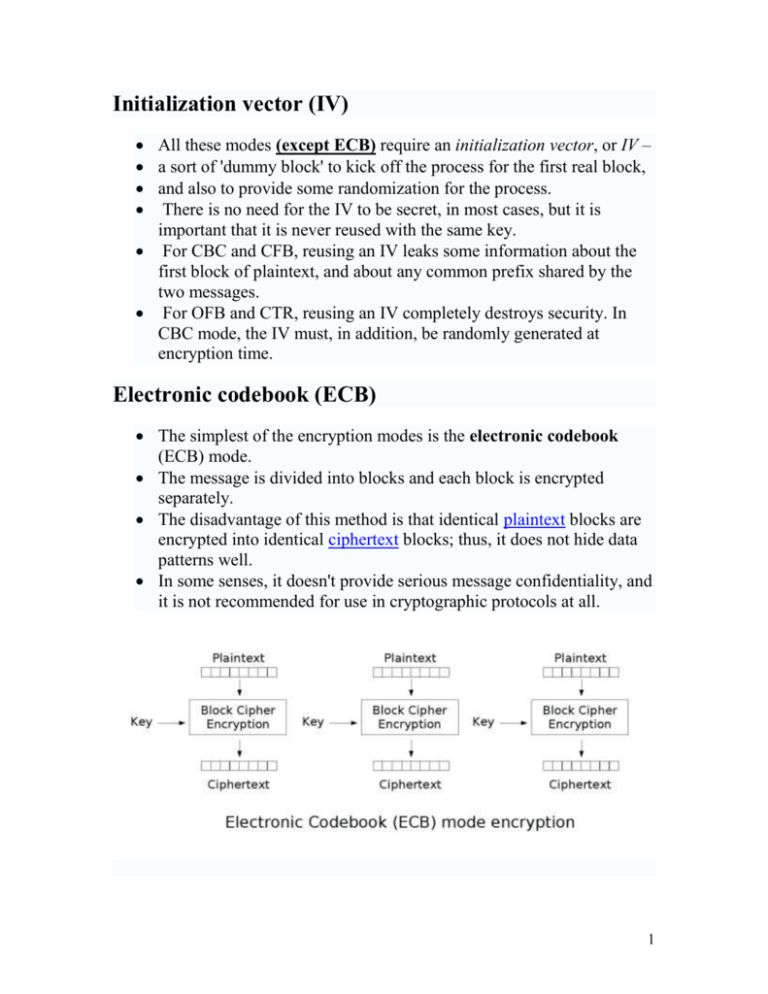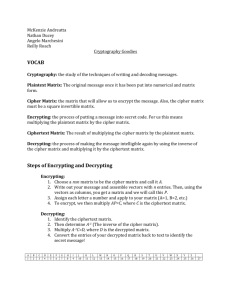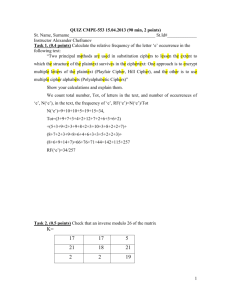Initialization vector (IV)
advertisement

Initialization vector (IV) All these modes (except ECB) require an initialization vector, or IV – a sort of 'dummy block' to kick off the process for the first real block, and also to provide some randomization for the process. There is no need for the IV to be secret, in most cases, but it is important that it is never reused with the same key. For CBC and CFB, reusing an IV leaks some information about the first block of plaintext, and about any common prefix shared by the two messages. For OFB and CTR, reusing an IV completely destroys security. In CBC mode, the IV must, in addition, be randomly generated at encryption time. Electronic codebook (ECB) The simplest of the encryption modes is the electronic codebook (ECB) mode. The message is divided into blocks and each block is encrypted separately. The disadvantage of this method is that identical plaintext blocks are encrypted into identical ciphertext blocks; thus, it does not hide data patterns well. In some senses, it doesn't provide serious message confidentiality, and it is not recommended for use in cryptographic protocols at all. 1 Here's a striking example of the degree to which ECB can leave plaintext data patterns in the ciphertext. A pixel-map version of the image on the left was encrypted with ECB mode to create the center image: Original Encrypted using ECB mode Encrypted using other modes The image on the right is how the image might look encrypted with CBC, CTR or any of the other more secure modes -- indistinguishable from random noise. Note that the random appearance of the image on the right tells us very little about whether the image has been securely encrypted; many kinds of insecure encryption have been developed which would produce output just as 'random-looking'. ECB mode can also make protocols without integrity protection even more susceptible to replay attacks, since each block gets decrypted in exactly the same way. For example, the Phantasy Star Online: Blue Burst online video game uses Blowfish in ECB mode. 2 Cipher-block chaining (CBC) In the cipher-block chaining (CBC) mode, each block of plaintext is XORed with the previous ciphertext block before being encrypted. This way, each ciphertext block is dependent on all plaintext blocks processed up to that point. Also, to make each message unique, an initialization vector must be used in the first block. 3 Properties of CBC CBC has been the most commonly used mode of operation. Its main drawbacks are that encryption is sequential (i.e., it cannot be parallelized), and that the message must be padded to a multiple of the cipher block size. Note that a one-bit change in a plaintext affects all following ciphertext blocks, and a plaintext can be recovered from just two adjacent blocks of ciphertext. As a consequence, decryption can be parallelized, and a one-bit change to the ciphertext causes complete corruption of the corresponding block of plaintext, and inverts the corresponding bit in the following block of plaintext. Cipher feedback (CFB) The cipher feedback (CFB) mode, a close relative of CBC, makes a block cipher into a self-synchronizing stream cipher. Operation is very similar; in particular, CFB decryption is almost identical to CBC decryption performed in reverse: 4 Like CBC mode, changes in the plaintext propagate forever in the ciphertext, and encryption cannot be parallelized. Also like CBC, decryption can be parallelized. When decrypting, a one-bit change in the ciphertext affects two plaintext blocks: a one-bit change in the corresponding plaintext block, and complete corruption of the following plaintext block. Later plaintext blocks are decrypted normally. Because each stage of the CFB mode depends on the encrypted value of the previous ciphertext XORed with the current plaintext value, a form of pipelining is possible, since the only encryption step which requires the plaintext is the final XOR. This is useful for applications that require low latency between the arrival of plaintext and the output of the corresponding ciphertext, such as certain applications of streaming media. CFB shares two advantages over CBC mode with the stream cipher modes OFB and CTR: o the block cipher is only ever used in the encrypting direction, and o the message does not need to be padded to a multiple of the cipher block size. 5 Output feedback (OFB) The output feedback (OFB) mode makes a block cipher into a synchronous stream cipher: it generates keystream blocks, which are then XORed with the plaintext blocks to get the ciphertext. Just as with other stream ciphers, flipping a bit in the ciphertext produces a flipped bit in the plaintext at the same location. This property allows many error correcting codes to function normally even when applied before encryption. Because of the symmetry of the XOR operation, encryption and decryption are exactly the same: 6 Each output feedback block cipher operation depends on all previous ones, and so cannot be performed in parallel. However, because the plaintext or ciphertext is only used for the final XOR, the block cipher operations may be performed in advance, allowing the final step to be performed in parallel once the plaintext or ciphertext is available. 7 Counter (CTR) Note: CTR mode is also known as Segmented Integer Counter (SIC) mode Like OFB, counter mode turns a block cipher into a stream cipher. It generates the next keystream block by encrypting successive values of a "counter". The counter can be any simple function which produces a sequence which is guaranteed not to repeat for a long time, although an actual counter is the simplest and most popular. CTR mode has similar characteristics to OFB, but also allows a random access property during decryption, and is believed to be as secure as the block cipher being used. Note that the nonce in this graph is the same thing as the initialization vector (IV) in the other graphs. The IV/nonce and the counter can be concatenated, added, or XORed together to produce the actual unique counter block for encryption. 8 9







